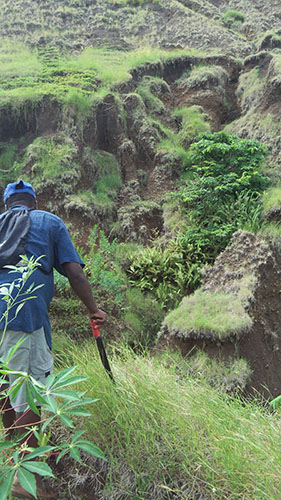Finally! 2015 is the year of soils! Ready the celebration. Polish your spade, pick, and shovel, and carefully wrap those gifts of organic fertilizer you’ve been hiding away. It’s going to be a hell of a party.
Humor aside, soil is obviously important in a number of very complex ways. The Food and Agriculture Organization of the UN (FAO) is spearheading the “2015 International Year of Soils” initiative to raise awareness of soil issues for food systems and broader environmental concerns. The director of the FAO, José Graziano da Silva, had the following to say of the importance of soil: “The multiple roles of soils often go unnoticed. Soils don’t have a voice, and few people speak out for them. They are our silent ally in food production” (as quoted on FAO’s website).
Yet as I’ve found researching soil conservation in Haiti in 2012 and examining the history of soil conservation more broadly, it seems that many people have spoken out for soils. In fact, through the panic related to the 1930s dustbowl crisis in the United States, soil erosion arguably became the first global environmental problem (Anderson 1984). This rapid spread of environmental concern highlights the way that soil has, in the past, captured the imagination and emotion of governments around the world. But the spread of soil conservation was not the seemingly de-politicized “awareness” campaign that we’re presented with by the FAO. Rather, in the 1930s, soil conservation was rooted in a desire to control and manipulate rural farmers. So while I’d agree with Mr. da Silva that soils do not have an “audible” voice, I’d argue that we need to pay far more attention to who speaks for soils and why.

Image: Haitian farmer and soil erosion in Haiti’s hillsides. Photo by author.
Despite being “inaudible,” soils certainly make themselves heard through dust storms and the work of soil conservation experts. In the Dustbowl years of the 1930s, clouds of dirt darkened the sun even as far east as Washington D.C. As the US jumped into crisis management mode, countries around the world looked to the American experience, fearing their own version of the sweeping dust storms caused by anthropogenic soil degradation.
Americans dealing with the issue of soil degradation constituted a new and growing set of “experts.” As this conservation science was exported across the globe, it was based on a very particular set of assumptions. These assumptions, first and foremost, were rooted in the idea that farmers are to blame for soil degradation, and therefore served to mask the actual causes of degradation. For example, beginning in the 1930s in Kenya, soil degradation was seen by conservationists not as related to the European introduction and overproduction of monocropped cereals, but rather erroneously linked to African animal husbandry. For colonial governments, African farmers were seen as the danger to soils, and international soil conservation became yet another mode of rural control. Resulting programs of planned conservation and forced migration were so coercive that rural agricultural intervention in Africa was deemed “the second occupation” (see Anderson 1984; Pretty and Shah 1997). The colonial administrations in India and Africa sought out the expertise of the US not only in managing soil, but managing and controlling farmers too.
Those who speak and advocate for soil are therefore not always advocating just for soil, but rather have been historically interested in using soil conservation as another form of control. Clearly this is concerning ethically. It can also produce some pretty shoddy environmental results. Without continued maintenance, structures built for the purpose of soil conservation can produce even more erosion than originally observed (see Pretty and Shah 1997).
However, there have been successful soil conservation interventions that have not only improved the wellbeing of soils but also the wellbeing of farmers (the classic example of Tiffen et al 1994). But it is essential to remember that a particular strain of soil conservation interventions has continually marginalized farmers from their own lands. In Haiti, my own research in 2012 examined how UN institutions have replicated soil conservation structures that are scientifically vetted, yet implemented with only cursory participation of the farmers and landowners themselves. As a result, there is little continued maintenance, and after a number of years the hillsides return to their former state. Far more interested in the short-term success of the project than in the long-term benefits to farmers and hillsides, such projects highlight the contradictions inherent in contemporary conservation efforts.
In contrast, Dominican and Haitian farmers I know are genuinely interested in improving the condition of their soils, and many take the steps that they can to do so. But larger institutional interventions that arrive may not recognize these intimate and ongoing relationships.
So while I will be the first to raise my spade to celebrate the 2015 year of soil, I will do so while questioning who gets to speak for the “silent” soils.
References:
Anderson, David. 1984. Depression, Dust Bowl, Demography, and Drought: The Colonial State and Soil Conservation in East Africa during the 1930s. African Affairs 83(332): 321–343.
Pretty, Jules N., and Parmesh Shah. 1997. Making Soil and Water Conservation Sustainable: From Coercion and Control to Partnerships and Participation. Land Degradation & Development 8(1): 39–58.
Tiffen, Mary, Michael Mortimore, and Francis Gichuki. 1994. More People, Less Erosion: Environmental Recovery in Kenya. John Wiley & Sons Ltd.
Editor’s note: the title of this post was updated on April 13, 2015 to “Who speaks for soil?”

1 Comment
Good stuff and I agree that soil does “speak” for itself, ultimately. That’s why we have to take care of it now. 😉